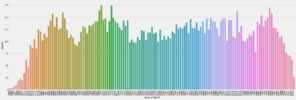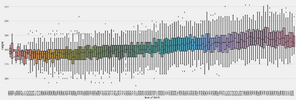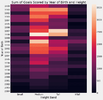Hoping this thread can do the heavy lifting on this topic instead of it all existing in the AFL draft thread 
As this is inspired by Nick Watson, I'm going to focus on small players whom we might think could be forwards, mids and forward mids. I am also including defender mids as that is what Caleb Daniels is classified as (according to Footywire) and we can't talk about short players in the AFL without talking about Caleb!
Here goes...
Firstly, I am using data from Footywire. That includes heights and positions. They are rounded to the nearest cm by Footywire. Don't hate me if some are wrong or off a bit. Caleb Daniels is listed as 170cm in this dataset and is the shortest player in the AFL. This analysis is to talk through the trends. Every player is unique and if they are playing in the afl, they must have something going for them. Also note, while I have all listed players in 2023 in the data, not all of them record a stat or even play a game. So there is some bias in the data in that some players just aren't good enough for the level. If this correlates with height then it might skew the results a little but not heaps. Just relax about Bias as I'm not going to solve this issue today
1. Distribution of height by position: You can see there are some clear distribution differences by position. the KDE curve predicts the distribution based on density. Just because a line extends down to 160 cm, doesn't mean there are any players at that height and position but because Caleb Daniels, anything is possible! What is suggests is that your chances of being a midfielder if you are sub 175cm are tiny. At sub 170, not even the KDE curve predicts it is possible. Similar story for Midfield Forward players. Of the 11 players who are less than 175 cm tall, they are all listed as forwards or defender forwards. If Watson is going to anything other than a permanent forward, he is going to have to be a unicorn based on the distribution of 2023 players.

What niche do shorter players
2. Goals: This chart has the distribution of players by height and goals per game (there are no position limitations in this chart or any like it that follow). Generally speaking, your sub-180cm players do make good goal scorers relative to 180-190cm players (noting there are many exceptional outlier goal scorers in that range also). At sub-180cm, players that aren't good goal scorers get elected out of the data as they, on average, have less position flexibility than 180-190cm players, who are found in almost every position.

3. Tackles inside 50: Sub-180cm players in the afl in 2023 are on average tackle inside fifty more than taller size ranges. Makes sense. If you are shorter, you are probably fast, play forward, kick goals and tackle. That is your job and you need to be better at it than a taller player, who might be a bit more versatile.

So what niche is hard to fill as a sub-180cm player? Inside midfielder. It is clearly not impossible (e.g. Neale, Serong) but the distribution of output in key metrics is well below those for 180-190cm players.
4. Clearances: Sub-180cm players do little better than KPP players (190-200cm). Caleb Daniel
aside, there isn't a player under 175cm averaging two clearances or more a game.

5. Centre Clearances: Looks worse for centre clearances than clearances in general, especially for sub-175cm players. IT doesn't look like they get many opportunities in the centre.

6. Stoppage Clearances: Similar story as the last two charts. The sub-175cm player appear to get most of their clearances from stoppages. Likely, forward fifty stoppages as opportunists rather than target players.

The moral of the story is, if you are drafting a sub-175cm player, you are drafting a small forward. Maybe pinch hit at stoppages and in the centre square but primarily you are drafting a small forward unless...that player is an absolute unicorn in every sense of the word (except the literal sense). A player could come along at Watson's height and be a dominant mid. But it would be without precedence in modern times and way outside the distribution of current players who are close to his height (no one is as short as Watson in the AFL). He has all the tools (except height I guess!) to make it as small forward and is a top 10 talent in this draft. As far as unicorns go, Caleb Daniel
is a unicorn stoppage player at almost the same height (depending on what listing you look at) and he isn't a dominant stoppage player by any means. IF Watson can do any better, he will be a truly remarkable player.
As this is inspired by Nick Watson, I'm going to focus on small players whom we might think could be forwards, mids and forward mids. I am also including defender mids as that is what Caleb Daniels is classified as (according to Footywire) and we can't talk about short players in the AFL without talking about Caleb!
Here goes...
Firstly, I am using data from Footywire. That includes heights and positions. They are rounded to the nearest cm by Footywire. Don't hate me if some are wrong or off a bit. Caleb Daniels is listed as 170cm in this dataset and is the shortest player in the AFL. This analysis is to talk through the trends. Every player is unique and if they are playing in the afl, they must have something going for them. Also note, while I have all listed players in 2023 in the data, not all of them record a stat or even play a game. So there is some bias in the data in that some players just aren't good enough for the level. If this correlates with height then it might skew the results a little but not heaps. Just relax about Bias as I'm not going to solve this issue today

1. Distribution of height by position: You can see there are some clear distribution differences by position. the KDE curve predicts the distribution based on density. Just because a line extends down to 160 cm, doesn't mean there are any players at that height and position but because Caleb Daniels, anything is possible! What is suggests is that your chances of being a midfielder if you are sub 175cm are tiny. At sub 170, not even the KDE curve predicts it is possible. Similar story for Midfield Forward players. Of the 11 players who are less than 175 cm tall, they are all listed as forwards or defender forwards. If Watson is going to anything other than a permanent forward, he is going to have to be a unicorn based on the distribution of 2023 players.

What niche do shorter players
2. Goals: This chart has the distribution of players by height and goals per game (there are no position limitations in this chart or any like it that follow). Generally speaking, your sub-180cm players do make good goal scorers relative to 180-190cm players (noting there are many exceptional outlier goal scorers in that range also). At sub-180cm, players that aren't good goal scorers get elected out of the data as they, on average, have less position flexibility than 180-190cm players, who are found in almost every position.
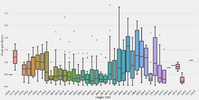
3. Tackles inside 50: Sub-180cm players in the afl in 2023 are on average tackle inside fifty more than taller size ranges. Makes sense. If you are shorter, you are probably fast, play forward, kick goals and tackle. That is your job and you need to be better at it than a taller player, who might be a bit more versatile.
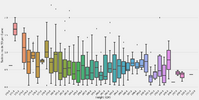
So what niche is hard to fill as a sub-180cm player? Inside midfielder. It is clearly not impossible (e.g. Neale, Serong) but the distribution of output in key metrics is well below those for 180-190cm players.
4. Clearances: Sub-180cm players do little better than KPP players (190-200cm). Caleb Daniel
PLAYERCARDSTART
35
Caleb Daniel
- Age
- 27
- Ht
- 171cm
- Wt
- 72kg
- Pos.
- M/F
Career
Season
Last 5
- D
- 21.3
- 5star
- K
- 11.5
- 4star
- HB
- 9.8
- 5star
- M
- 3.5
- 4star
- T
- 2.9
- 4star
- CL
- 1.4
- 4star
- D
- 19.5
- 4star
- K
- 11.1
- 4star
- HB
- 8.4
- 4star
- M
- 3.6
- 4star
- T
- 2.0
- 3star
- CL
- 1.0
- 3star
- D
- 16.4
- 4star
- K
- 7.2
- 3star
- HB
- 9.2
- 5star
- M
- 3.4
- 4star
- T
- 2.6
- 4star
- CL
- 0.2
- 2star
PLAYERCARDEND
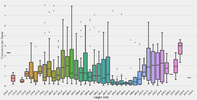
5. Centre Clearances: Looks worse for centre clearances than clearances in general, especially for sub-175cm players. IT doesn't look like they get many opportunities in the centre.

6. Stoppage Clearances: Similar story as the last two charts. The sub-175cm player appear to get most of their clearances from stoppages. Likely, forward fifty stoppages as opportunists rather than target players.
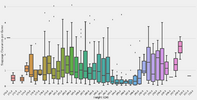
The moral of the story is, if you are drafting a sub-175cm player, you are drafting a small forward. Maybe pinch hit at stoppages and in the centre square but primarily you are drafting a small forward unless...that player is an absolute unicorn in every sense of the word (except the literal sense). A player could come along at Watson's height and be a dominant mid. But it would be without precedence in modern times and way outside the distribution of current players who are close to his height (no one is as short as Watson in the AFL). He has all the tools (except height I guess!) to make it as small forward and is a top 10 talent in this draft. As far as unicorns go, Caleb Daniel
PLAYERCARDSTART
35
Caleb Daniel
- Age
- 27
- Ht
- 171cm
- Wt
- 72kg
- Pos.
- M/F
Career
Season
Last 5
- D
- 21.3
- 5star
- K
- 11.5
- 4star
- HB
- 9.8
- 5star
- M
- 3.5
- 4star
- T
- 2.9
- 4star
- CL
- 1.4
- 4star
- D
- 19.5
- 4star
- K
- 11.1
- 4star
- HB
- 8.4
- 4star
- M
- 3.6
- 4star
- T
- 2.0
- 3star
- CL
- 1.0
- 3star
- D
- 16.4
- 4star
- K
- 7.2
- 3star
- HB
- 9.2
- 5star
- M
- 3.4
- 4star
- T
- 2.6
- 4star
- CL
- 0.2
- 2star
PLAYERCARDEND






